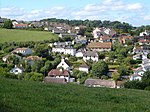Dawlish railway station
1846 establishments in EnglandDawlishDfT Category D stationsFormer Great Western Railway stationsGrade II listed buildings in Devon ... and 9 more
Grade II listed railway stationsIncomplete lists from September 2017Pages with no open date in Infobox stationRailway stations in DevonRailway stations in Great Britain opened in 1846Railway stations on the South West Coast PathRailway stations served by CrossCountryRailway stations served by Great Western RailwayUse British English from September 2017

Dawlish railway station is on the Exeter to Plymouth line and serves the seaside resort town of Dawlish in Devon, England. It is located 206 miles 7 chains (331.7 km) from London Paddington, via Box.The station is built on the sea wall, as is the railway line, and has often suffered from storm damage due its proximity to the sea. South of the station, the railway passes through five tunnels in the cliffs as it follows the coastline.
Excerpt from the Wikipedia article Dawlish railway station (License: CC BY-SA 3.0, Authors, Images).Dawlish railway station
Richmond Place, Teignbridge
Geographical coordinates (GPS) Address Nearby Places Show on map
Geographical coordinates (GPS)
| Latitude | Longitude |
|---|---|
| N 50.5805 ° | E -3.4645 ° |
Address
Richmond Place
EX7 9PJ Teignbridge
England, United Kingdom
Open on Google Maps










